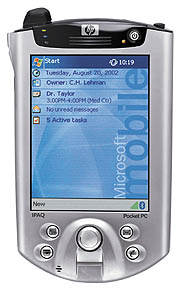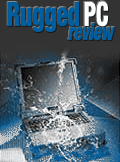The first iPAQs to carry the HP brand name
(Pen Computing Magazine, December 2002 issue) --
Don't these design engineers ever sleep? The first professional iPAQ to carry the Hewlett Packard brand offers such a wealth of features it's a wonder that it doesn't just burst its slim metal shell right open.

Fingerprint + password = true security
Clearly the biggest news about the iPAQ 5400 series is the integrated biometric security using a fingerprint scanner. Just below the "joypad" 5-way selector is a thermal scanner that you swipe your index finger down to unlock the machine. After a few minutes of training the thing to recognize one or (preferably) both of your index fingers, the device can be set to open with a swipe only or a swipe in combination with a PIN or password. It sounds fiddly, but I found using fingerprint security easy, reliable, and even a bit fun.
Double-barreled wireless
Like its predecessors, the 3800/3900 series, Bluetooth is standard issue in the 5400. What's exciting is the inclusion of integrated WiFi (802.11b) wireless Ethernet LAN connectivity. The antenna nub is far less annoying than the wide, flat antennae found in CF card WiFi adapters and is far less likely to snag on something and break. In my tests with a pre-production 5450, I found no problems running both wireless protocols simultaneously. This is an impressive feat considering that both use the same unlicensed radio spectrum. I'll bet there were some truly gnarly interference and noise issues worked out with some rococo internal shielding.
These tweakers don't suck
In their endless quest to squeeze more battery life out of increasingly powerful devices, these sleepless engineers have added two new conservation settings. Standby lets you reduce the amount of standby time your iPAQ will reserve, giving you another half-hour or so of uptime between charges. USB Charging allows you control over trickle charging via a USB port -- potentially handy for power emergencies in the field.
HP wisely chose not to make the new iPAQ incompatible with existing expansion jackets and charge cradles. Neither did they mess with the excellent built-in software complement, including the delightful Nevo universal remote control. They did, however, do something really smart by making the lithium-polymer battery pack removable, though doing so necessitated reducing the power slightly from 1400 to 1350 mAH. The black plastic forehead has thankfully shrunk a few millimeters and that brilliant transflective display has been moved up to accommodate the fingerprint scanner. Overall, the new iPAQ looks a bit more businesslike than the 3900 while still retaining the appeal of the original design. Look for a full review of the production 5450 in the next issue.
HP iPAQ h1910
 There is a clear stratification emerging in the handheld market. What might be dubbed "lifestyle" devices featuring diminutive proportions, low cost and limited functionality are contrasting with "professional" machines bristling with wireless communications features, tons of memory, and myriad expansion capabilities. Palm's new US$99 Zire and their powerful new US$499 Tungsten business-class machines illustrate this nicely.
There is a clear stratification emerging in the handheld market. What might be dubbed "lifestyle" devices featuring diminutive proportions, low cost and limited functionality are contrasting with "professional" machines bristling with wireless communications features, tons of memory, and myriad expansion capabilities. Palm's new US$99 Zire and their powerful new US$499 Tungsten business-class machines illustrate this nicely.
HP is going the same route with their new consumer iPAQ 1910. Pricing was not finalized at press time, and HP did not have a preproduction sample for us to play with, but we are guessing it will weigh in at a reasonable US$299. With its transflective display, that puts the 1910 in competition with the new ViewSonic V35 (see review on page 73). Whether these streamlined Pocket PCs can encroach onto Palm's consumer turf remains to be seen.
-David MacNeill
Contact: Hewlett Packard www.hp.com
|



 There is a clear stratification emerging in the handheld market. What might be dubbed "lifestyle" devices featuring diminutive proportions, low cost and limited functionality are contrasting with "professional" machines bristling with wireless communications features, tons of memory, and myriad expansion capabilities. Palm's new US$99 Zire and their powerful new US$499 Tungsten business-class machines illustrate this nicely.
There is a clear stratification emerging in the handheld market. What might be dubbed "lifestyle" devices featuring diminutive proportions, low cost and limited functionality are contrasting with "professional" machines bristling with wireless communications features, tons of memory, and myriad expansion capabilities. Palm's new US$99 Zire and their powerful new US$499 Tungsten business-class machines illustrate this nicely.